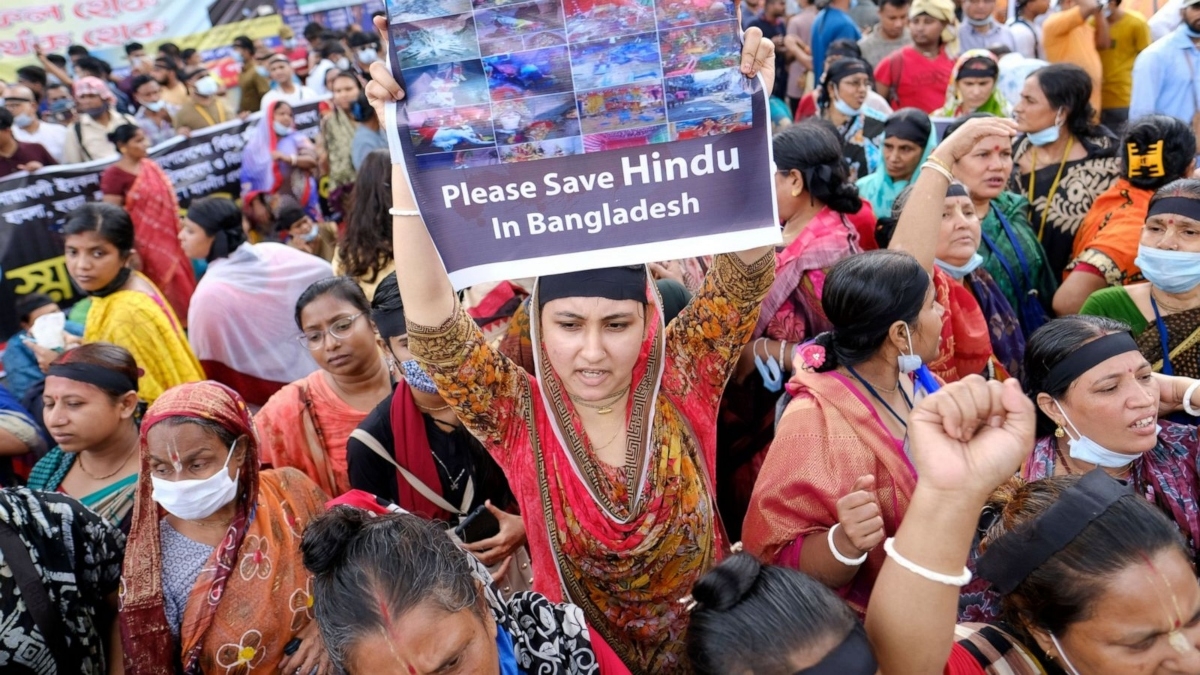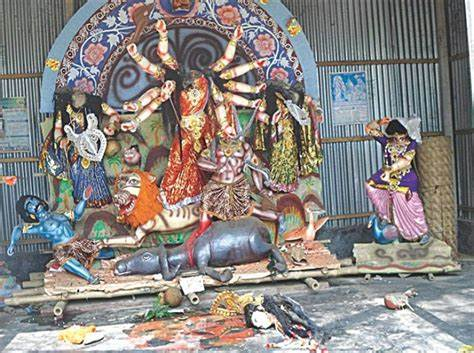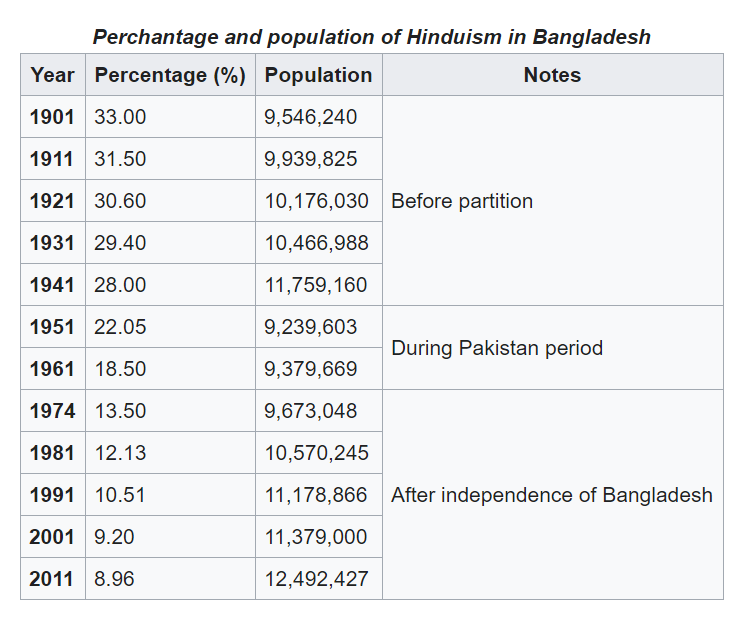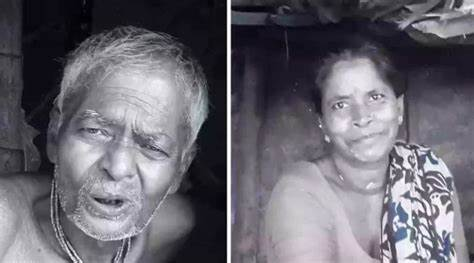Hindu persecution in the Indian subcontinent has been on the rise lately. Atrocities and forced-conversion suffered by Hindus continues to be sidelined by the governments and global media in India’s neighbouring countries. The exodus of the displaced and persecuted Hindus from Bangladesh began in 1905. The migration numbers reached two major crescendos in history; firstly, during the Partition of India and then the Independence of Bangladesh. The Hindus from this region continue to seek refuge in India till present date. Hinduism is the second largest religious affiliation in People's Republic of Bangladesh, as according to the 2022 Census of Bangladesh, approximately 13.1 million people responded that they were Hindus, constituting 7.95% out of the total population of 165.15 million people. In terms of population, Bangladesh is the third-largest Hindu populated country of the world, just after the neighbouring republics of India and Nepal in the subcontinent. Hinduism is the second-largest religion in 61 out of 64 districts of Bangladesh, but there is no Hindu majority district in Bangladesh. The Government of Bangladesh proclaimed that it is dedicated to ensuring the safety and security of the Hindu minority community.
History of Bengal steeped in Hate-Crimes against Hindus
The seeds of the Islamification of Bengal lie in the pre-independence Bengal Sultanate. Although independent Hindu kingdoms flourished in the Bengal region till the advent of the colonial era, the subjugation of non-Islamic population in the region had gained traction over the centuries; thereby resulting in increased forced-conversion to Islam.
The British exploited the increasing religious dissent as part of their “Divide and Rule” policy. This led to the first partition of Bengal in 1905 which firmly shaped the socio-religious and political divide of Bengal. Hence, the idea of “Partition” in India along the religious lines gained its credence from Bengal itself. Finally, this idea led to the partition of India with East Bengal becoming East Pakistan resulting in an ever increasing corollary of violence against Hindus.
EVENTS LIKE “DIRECT ACTION DAY” AND “NOAKHALI MASSACRE” BECAME THE INFAMOUS SYMBOLS OF GROSS VIOLENCE AGAINST THE HINDUS LEADING TO THE FLIGHT OF NATIVE HINDUS FROM EAST PAKISTAN. A TOTAL OF 10,000 HINDU DEATHS CAN BE LAID AT THE DOORS OF THESE EVENTS.
Radical terrors that modern Hindus face in Bangladesh

The stable government of Bangladesh has led the country to have a higher per capita GDP than Inada, the radical elements of the country continue their anti-Hindu practices. The Bangladeshi Islamist rape, murder, attack temples, and conduct forced-conversions against Hindus continue to be misreported by media and the government.
In 2022 alone, 154 Hindus were murdered in Bangladesh in an act of Islamic extremism. 319 Hindu homes were set ablaze and 572 families were evicted in Bangladesh last year alone. A shocking number of 66 Hindu women were raped; 17 of which were killed after the heinous act. Moreover, 152 women were forcefully converted to Islam. 2022 also saw the destruction of 481 Hindu idols in the country. And a total of 319 temple properties were seized by the Islamic miscreants.
In 2023 there were a series of planned attacks on 14 temples of Bangladesh. Several acts of organized terror were inflicted on Hindu families and business owners in Bangladesh. Even today, there are families that have been barricaded inside their own village for no rational cause. Crimes against women are rising astronomically in the Radical Bangladesh.
Although authorities attempt to find justice for all victims, the current state of Hindus in the land of their forefathers should leave the government shamefaced. The local officials are often unable to resist the radical elements of society; and they often arrive to aid the Hindus a minute too late. The laws of protection of culture seem to be ineffective in pseudo-secular Bangladesh. In conclusion Hindus have never been and will never be safe in Bangladesh.
Culture
In nature, Bangladeshi Hinduism closely resembles the forms and customs of Hinduism practiced in the neighbouring Indian state of West Bengal, with which Bangladesh (at one time known as East Bengal) was united until the partition of India in 1947. The vast majority of Hindus in Bangladesh are Bengali Hindus.
Goddess (Devi) – usually venerated as Durga or Kali – is widely revered, often alongside her consort Shiva. The worship of Shiva has generally found adherents among the higher castes in Bangladesh. Worship of Vishnu (typically in the form of his Avatars or incarnationRama or Krishna) more explicitly cuts across caste lines by teaching the fundamental oneness of humankind in spirit. Vishnu worship in Bengal expresses the union of the male and female principles in a tradition of love and devotion. This form of Hindu belief and the Sufi tradition of Islam have influenced and interacted with each other in Bengal. Both were popular mystical movements emphasizing the personal relationship of religious leaders and disciples instead of the dry stereotypes of the Brahmins or the Ulama. As in Bengali Hindu practice, worship of Vishnu frequently occurs in a small devotional society (shomaj). Both use the language of earthly love to express communion with the divine. In both traditions, the Bengali language is the vehicle of a large corpus of mystical literature of great beauty and emotional impact.
In Bangladeshi Hinduism ritual bathing, vows, and pilgrimages to sacred rivers, mountains, and shrines are common practices. An ordinary Hindu will worship at the shrines of Muslim pirs, without being concerned with the religion to which that place is supposed to be affiliated. Hindus revere many holy men and ascetics conspicuous for their bodily mortifications. Some believe that they attain spiritual benefit merely by looking at a great holy man. Durga Puja, held in September–October, is the most important festival of Bangladeshi Hindus and it is widely celebrated across Bangladesh. Thousands of pandals (mandaps) are set up in various cities, towns, and villages to mark the festival. Other festivals are Kali Puja, Janmashtami, Holi, Saraswati Puja, Shivratri and Rathayatra, the most popular being the century-old Dhamrai Rathayatra.
Demographics

According to the 2001 Bangladesh census, there were around 11.82 million Hindus in Bangladesh constituting 9.6% of the population, which at the time was 123.15 million. The Bangladesh 2011 census states, that approximately 12.73 million people responded that they were Hindus, constituting 8.54% of the total 149.77 million. While 2022 Census of Bangladesh, put the number of Hindus in Bangladesh at 13.1 million out of total 165.1 million population, thus constituting 7.95% of the population. According to a report published by a local daily newspaper of Bangladesh, the Hindu population in the country has reduced by nearly one million between 2001 and 2011 period. The reduction mainly happened in nine districts – Bhola, Barisal, Jhalokati, Pirojpur, Bagerhat, Narail, Gopalganj, Rajbari and Manikganj. The United States Commission on International Religious Freedom have said that Hindus constitute merely 7% of the population in Bangladesh as per as the latest 2016 figures. Hindus in Bangladesh in the late 2000s were almost evenly distributed in all regions, with large concentrations in Gopalganj, Dinajpur, Sylhet, Sunamganj, Mymensingh, Khulna, Jessore, Chittagong and parts of Chittagong Hill Tracts. In the capital city of Dhaka, Hindus are the second-largest religious community after the Muslims and the largest concentration of Hindus can be found in and around Shankhari Bazaar of the old city.
Missing population
With migration into West Bengal, the 1947 partition of Bengal significantly altered religious demographics in the eastern segment of the province, which later became Bangladesh. Violence also saw an uptick in the 1950s and 1960s in what had then become East Pakistan (present-day-Bangladesh), leading to large numbers of upper caste Bengali Hindus migrating to West Bengal, Assam and Tripura with official Indian Government records indicating 4.12 million (Hindu) refugees crossed into India from East Bengal between 1947 and 1958.
Utilizing demography studies and other methods over a 55-year period from 1947 to 2001, professor Sachi Dastidar of the State University of New York calculates that well over 49 million Hindus are missing today from Bangladesh. Ergo in the absence of partition in 1947 and other events that followed, it is estimated the present-day Bangladeshi hindu population would be approximately 62.73 million or 31.4%, well above the current population of 12.73 million or 8.5%, as reported in the Bangladesh 2011 census.
According to a report published by a local daily newspaper of Bangladesh, the Hindu population in the country has reduced by 1 million between 2001 and 2011 period. After the 1960s, most of the migration was lower caste – a trend that has continued to till this day. As per a BJP estimate, Bangladeshi Hindu immigrants are a significant presence in 75 Assembly constituencies – making up approximately a fourth of the state's seats.
Community issues
The Hindu community has many similar issues as the predominantly Muslim community of Bangladesh. These include women's rights, dowry, poverty, unemployment, and others. Issues unique to the Hindu community include maintenance of Hindu culture and temples in Bangladesh. Small sects of Islamists constantly try to politically and socially isolate the Hindus of Bangladesh. Because Hindus of Bangladesh are scattered across all areas (except in Narayanganj), they cannot unite politically. However, Hindus became sway voters in various elections. Hindus have usually voted in large mass for Bangladesh Awami League and communist parties, as these are the only parties which have a nominal commitment to secularism; the alternatives are the increasingly pro-Islamist centrist parties such as the Bangladesh Nationalist Party and Jatiya Party (which both incorporate Muslim identity into their version of Bangladeshi nationalism) or the outright Islamist Jamaat-e-Islami Bangladesh (an offshoot of the Pakistan-based Jamaat-e-Islami) which seeks to establish Islamic law under which there would be separate provisions for Hindus as non-Muslims. However, Hindus, in general, maintain cordial relationships with liberal Muslims and they even participate in each other's festivals such as Durga Puja and Eid al-Fitr.
Current News
10 radical Islamists arrested for killing a Hindu couple in Bangladesh

After an extensive 16-day investigation, ten radical Islamists have been arrested by the local police in Chandpur, including the masterminds, Sohag Munsi and Mizan, for the brutally killing a Hindu man and his wife in the district of Chandpur, Bangladesh. The suspects have reportedly confessed to their involvement in the crime, which was apparently motivated by a scheme to seize the couple’s property.
The victims, identified as Uttam Barman (68) and Kajoli Rani Barman (55), were found lifeless on the morning of September 8th in Hajipur, Chandpur district. Uttam Barman had been working as a caretaker and resided in the mansion of affluent Hindu resident Dulal Saha. Dulal Saha and his family, including his wife, had been living in Narayanganj town.
The Superintendent of Police in Chandpur addressed the media during a press briefing, shedding light on the tragic incident. He stated, “The couple identified some of the culprits. So, they were killed. We have arrested 10 people so far.”
This shocking incident raises concerns about the safety and security of the Hindu minority community in Bangladesh. Reports of targeted violence against religious minorities have been on the rise in recent years, sparking fears among the Hindu population and drawing international attention to their plight.
The government of Bangladesh has a responsibility to protect the rights and safety of all its citizens, regardless of their religious or ethnic backgrounds. Advocacy groups and human rights organizations are calling for a thorough investigation into the incident, as well as heightened security measures to prevent further violence against the Hindu minority

